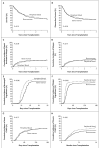Peripheral-blood stem cells versus bone marrow from unrelated donors
- PMID: 23075175
- PMCID: PMC3816375
- DOI: 10.1056/NEJMoa1203517
Peripheral-blood stem cells versus bone marrow from unrelated donors
Abstract
Background: Randomized trials have shown that the transplantation of filgrastim-mobilized peripheral-blood stem cells from HLA-identical siblings accelerates engraftment but increases the risks of acute and chronic graft-versus-host disease (GVHD), as compared with the transplantation of bone marrow. Some studies have also shown that peripheral-blood stem cells are associated with a decreased rate of relapse and improved survival among recipients with high-risk leukemia.
Methods: We conducted a phase 3, multicenter, randomized trial of transplantation of peripheral-blood stem cells versus bone marrow from unrelated donors to compare 2-year survival probabilities with the use of an intention-to-treat analysis. Between March 2004 and September 2009, we enrolled 551 patients at 48 centers. Patients were randomly assigned in a 1:1 ratio to peripheral-blood stem-cell or bone marrow transplantation, stratified according to transplantation center and disease risk. The median follow-up of surviving patients was 36 months (interquartile range, 30 to 37).
Results: The overall survival rate at 2 years in the peripheral-blood group was 51% (95% confidence interval [CI], 45 to 57), as compared with 46% (95% CI, 40 to 52) in the bone marrow group (P=0.29), with an absolute difference of 5 percentage points (95% CI, -3 to 14). The overall incidence of graft failure in the peripheral-blood group was 3% (95% CI, 1 to 5), versus 9% (95% CI, 6 to 13) in the bone marrow group (P=0.002). The incidence of chronic GVHD at 2 years in the peripheral-blood group was 53% (95% CI, 45 to 61), as compared with 41% (95% CI, 34 to 48) in the bone marrow group (P=0.01). There were no significant between-group differences in the incidence of acute GVHD or relapse.
Conclusions: We did not detect significant survival differences between peripheral-blood stem-cell and bone marrow transplantation from unrelated donors. Exploratory analyses of secondary end points indicated that peripheral-blood stem cells may reduce the risk of graft failure, whereas bone marrow may reduce the risk of chronic GVHD. (Funded by the National Heart, Lung, and Blood Institute-National Cancer Institute and others; ClinicalTrials.gov number, NCT00075816.).
Figures


Comment in
-
Pursuing the goal of a donor for everyone in need.N Engl J Med. 2012 Oct 18;367(16):1555-6. doi: 10.1056/NEJMe1209982. N Engl J Med. 2012. PMID: 23075182 No abstract available.
-
Peripheral-blood versus bone marrow stem cells.N Engl J Med. 2013 Jan 17;368(3):288. doi: 10.1056/NEJMc1214025. N Engl J Med. 2013. PMID: 23323911 No abstract available.
-
Peripheral-blood versus bone marrow stem cells.N Engl J Med. 2013 Jan 17;368(3):287-8. doi: 10.1056/NEJMc1214025. N Engl J Med. 2013. PMID: 23323912 No abstract available.
References
-
- Russell NH, Hunter A, Rogers S, Hanley J, Anderson D. Peripheral blood stem cells as an alternative to marrow for allogeneic transplantation. Lancet. 1993;341:1482. - PubMed
-
- Dreger P, Suttorp M, Haferlach T, Löffler H, Schmitz N, Schroyens W. Allogeneic granulocyte colony-stimulating factor-mobilized peripheral blood progenitor cells for treatment of engraftment failure after bone marrow transplantation. Blood. 1993;81:1404–7. - PubMed
-
- Körbling M, Przepiorka D, Huh YO, et al. Allogeneic blood stem cell transplantation for refractory leukemia and lymphoma: potential advantage of blood over marrow allografts. Blood. 1995;85:1659–65. - PubMed
-
- Schmitz N, Dreger P, Suttorp M, et al. Primary transplantation of allogeneic peripheral blood progenitor cells mobilized by filgrastim (granulocyte colony-stimulating factor) Blood. 1995;85:1666–72. - PubMed
-
- Bensinger WI, Weaver CH, Appelbaum FR, et al. Transplantation of allogeneic peripheral blood stem cells mobilized by recombinant human granulocyte colony-stimulating factor. Blood. 1995;85:1655–8. - PubMed
Publication types
MeSH terms
Associated data
Grants and funding
- U10 HL069294/HL/NHLBI NIH HHS/United States
- P30 CA016672/CA/NCI NIH HHS/United States
- UG1 HL069286/HL/NHLBI NIH HHS/United States
- U10 HL069254/HL/NHLBI NIH HHS/United States
- U10 HL069290/HL/NHLBI NIH HHS/United States
- U10 HL069301/HL/NHLBI NIH HHS/United States
- U10 HL069330/HL/NHLBI NIH HHS/United States
- U10HL069294/HL/NHLBI NIH HHS/United States
- U10 HL069348/HL/NHLBI NIH HHS/United States
- U24 CA076518/CA/NCI NIH HHS/United States
- U10 HL069286/HL/NHLBI NIH HHS/United States
- U10 HL069249/HL/NHLBI NIH HHS/United States
- U10 HL069334/HL/NHLBI NIH HHS/United States
LinkOut - more resources
Full Text Sources
Other Literature Sources
Medical
Research Materials
